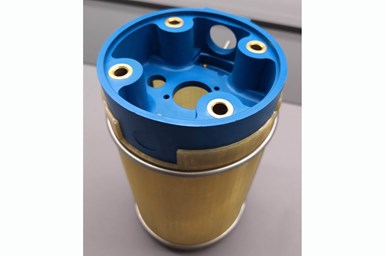Armor’s Additive Manufacturing Supports Railway Maintenance
AM proved to be the right choice for replacing a railway replacement part based on economic, technical and lead time constraints.

Armor utilized 3D printing to produce small runs of a replacement railway part.
French manufacturer Armor and its additive manufacturing (AM) brand Kimya were recently able to assist a railway supplier with replacement parts produced through AM. The supplier needed hood parts for which molds dating from 1982 no longer existed, so it turned to Kimya to produce small runs of the plastic part which needed to meet the requirements of fire and smoke regulations.
Highly flexible and responsive, AM is an ideal solution for improving production processes, the company says. Using its expertise in AM production in small runs, Kimya was able to produce a plastic part solely from a paper plan and the 3D file of a train part originally made out of PVC.
“Designing a traditional mold would have required a longer development time and generated costs that could only be covered by producing thousands of parts,” explains Pierre-Antoine Pluvinage, business development director at Kimya – additive manufacturing by Armor. “The Kimya factory offers our partners a fit-for-purpose finished product using our own materials, all in small runs.”
The production featured high-performance materials suitable for some of the most demanding technical applications. In order to meet the highly specific certification criteria of the rail sector, Armor offered the customer its high-performance material PEKK SC, which meets the smoke/fire certification requirements of the EN45545 standard. Designed to resist high temperatures (260°C/500°F), the PEKK SC filament also offers resistance against abrasion and chemicals, and is a flame retardant.
The railway supplier compared several technologies for manufacturing these parts in small quantities and AM proved to be the right choice from an economic, technical and lead time standpoint. Assembly testing conducted by Armor and the submission of the first article inspection quality file led to successful completion of the entire quality acceptance process for these AM parts. According to the railway supplier, only 3D printing was able to meet its demands with such efficiency.
Related Content
-
United Performance Metals Is the One-Stop Build Plate Shop for Production AM
United Performance Metals (UPM) started producing build plates for metal 3D printing in 2019. Now, the company offers full refurbishment and inventory management for this critical additive supply — with more to come.
-
Incus Successfully Tests Lithography-Based Metal Manufacturing for Lunar Environment
The project aim was to develop a sustainable process that uses lunar resources and recycled scrap metals (eventually contaminated by lunar dust) to produce spare parts on-site which could help and enhance human settlement on the moon.
-
UPM Additive Solutions and Authentise Develop Vendor Managed Inventory Solution for Additive Manufacturing
The Vendor Managed Inventory (VMI) solution for additive manufacturing streamlines inventory management, ensuring that critical materials are always available and minimizing the need for manual intervention.














